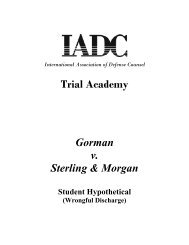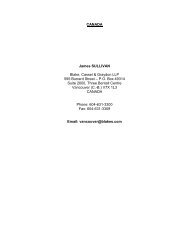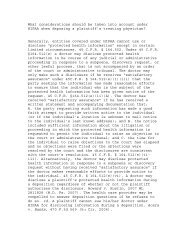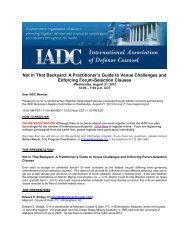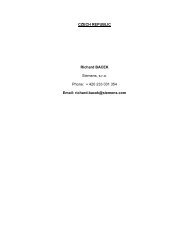Defense Counsel Journal - International Association of Defense ...
Defense Counsel Journal - International Association of Defense ...
Defense Counsel Journal - International Association of Defense ...
You also want an ePaper? Increase the reach of your titles
YUMPU automatically turns print PDFs into web optimized ePapers that Google loves.
Court-Imposed Time Limits on Trial Page 389the court, as did the discovery, while thefinal trial settled just prior to trial.Judges outside the mass tort productsliability context have also imposed timelimits for trials. Last year, Judge Alvin K.Hellerstein <strong>of</strong> the United States DistrictCourt for the Southern District <strong>of</strong> NewYork announced his plan to impose a onemonthtime limit for trial in a wrongfuldeath case filed by the family <strong>of</strong> MarkBavis, a passenger on the second plane tohit the World Trade Center on September11, 2001. 4 United Airlines and severalother parties were defendants. Had thecase not settled, each side would have hadno more than 50 to 60 hours to present itsevidence. The trial was to be timed inminutes, not days, much like a chessmatch with the clock ticking whenever alawyer questions a witness or argues tothe jury. As is <strong>of</strong>ten the case, lawyers forboth sides argued that such a time limitwas unrealistic for a case <strong>of</strong> thatmagnitude. Nevertheless, JudgeHellerstein fully intended to impose astrict time limit to avoid a protracted trialand to keep the jury focused. The courtreportedly reasoned that “once the jurygets bored with your presentation, you’velost the significant power <strong>of</strong> persuasion.”II. Standards Supporting TimeLimitationWhen imposing time limits at trial,federal district courts rely on varioussources, including FED. R. EVID. Rule611(a), which provides that:4 Bavis v. United Air Lines, Inc., No. 02-CV-7154-AKH (S.D.N.Y.).The court should exercise reasonablecontrol over the mode and order <strong>of</strong>examining witnesses and presentingevidence so as to:(1) Make those procedures effectivefor determining the truth;(2) Avoid wasting time; and(3) Protect witnesses from harassmentor undue embarrassment. 5State trial courts are afforded similardiscretion under state or local procedureand/or evidence rules, or common lawprinciples. 65 FED. R. EVID. 611(a); see also Gregory P.Joseph, American Bar Assoc. Princ. for Juries& Jury Trials, SL 044 ALI-ABA 653 (Oct.2005) (citing FED. R. CIV. P. 16(c)(4), (c)(15)(“the court may take appropriate action, withrespect to…an order establishing a reasonablelimit on the time allowed for presentation <strong>of</strong>evidence”)); FED. R. EVID. 403, 611(a), 201,and MANUAL FOR COMPLEX LITIGATION(THIRD) §§ 21.653, 22.35 (1995) (providesgrounds for time limits); MCICommunications v. American Tel. & Tel. Co.,708 F.2d 1081, 1171 (7th Cir. 1983) (no abuse<strong>of</strong> discretion to limit antitrust trial to 26 dayseven where parties estimated an eight- to ninemonthtrial). See also Duquesne Light Co. v.Westinghouse Elec. Corp., 66 F.3d 604, 608-611 (3rd Cir. 1995); Crabtree v. Nat'l SteelCorp., 261 F.3d 715, 720-721 (7th Cir. 2001);Johnson v. Ashby, 808 F.2d 676, 678-679 (8thCir. 1987); Gen. Signal Corp. v. MCITelecomm. Corp., 66 F.3d 1500, 1508-1509(9th Cir. 1995).6 Further evidence <strong>of</strong> the judiciary’s interest inpromoting efficiency in litigation is thegrowing tendency <strong>of</strong> courts to implement timerestrictions in pretrial proceedings. Forexample, trial courts are issuing more tailoredand aggressive scheduling orders to expeditediscovery and, in some cases, promote prompt



